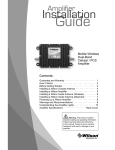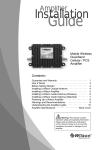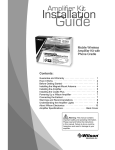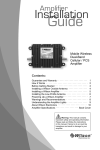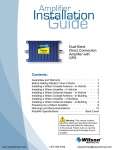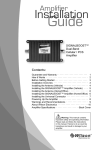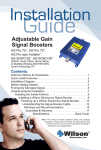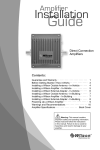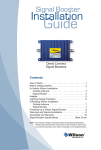Download Wilson Electronics 271245 Installation guide
Transcript
Amplifier Installation Guide SOHO Wireless DualBand Cellular / PCS Amplifi er Contents: Guarantee and Warranty ∙ ∙ ∙ ∙ ∙ ∙ ∙ ∙ ∙ ∙ ∙ ∙ ∙ ∙ ∙ ∙ ∙ ∙ ∙ ∙ ∙ ∙ ∙ ∙ 1 Antenna Options ∙ ∙ ∙ ∙ ∙ ∙ ∙ ∙ ∙ ∙ ∙ ∙ ∙ ∙ ∙ ∙ ∙ ∙ ∙ ∙ ∙ ∙ ∙ ∙ ∙ ∙ ∙ ∙ ∙ ∙ 2 How It Works ∙ ∙ ∙ ∙ ∙ ∙ ∙ ∙ ∙ ∙ ∙ ∙ ∙ ∙ ∙ ∙ ∙ ∙ ∙ ∙ ∙ ∙ ∙ ∙ ∙ ∙ ∙ ∙ ∙ ∙ ∙ ∙ ∙ 3 Before Getting Started ∙ ∙ ∙ ∙ ∙ ∙ ∙ ∙ ∙ ∙ ∙ ∙ ∙ ∙ ∙ ∙ ∙ ∙ ∙ ∙ ∙ ∙ ∙ ∙ ∙ ∙ 3 Installation Overview ∙ ∙ ∙ ∙ ∙ ∙ ∙ ∙ ∙ ∙ ∙ ∙ ∙ ∙ ∙ ∙ ∙ ∙ ∙ ∙ ∙ ∙ ∙ ∙ ∙ ∙ ∙ 3 Installing the Outside Antenna ∙ ∙ ∙ ∙ ∙ ∙ ∙ ∙ ∙ ∙ ∙ ∙ ∙ ∙ ∙ ∙ ∙ ∙ ∙ 4 Installing the Inside Antenna ∙ ∙ ∙ ∙ ∙ ∙ ∙ ∙ ∙ ∙ ∙ ∙ ∙ ∙ ∙ ∙ ∙ 5 Installing the Amplifi er ∙ ∙ ∙ ∙ ∙ ∙ ∙ ∙ ∙ ∙ ∙ ∙ ∙ ∙ ∙ ∙ ∙ ∙ ∙ ∙ ∙ ∙ ∙ ∙ ∙ ∙ 6 Powering up a Wilson Amplifi er ∙ ∙ ∙ ∙ ∙ ∙ ∙ ∙ ∙ ∙ ∙ ∙ ∙ ∙ ∙ ∙ ∙ ∙ ∙ 7 Understanding the Amplifi er Lights ∙ ∙ ∙ ∙ ∙ ∙ ∙ ∙ ∙ ∙ ∙ ∙ ∙ ∙ ∙ ∙ ∙ 8 Warnings and Recommendations ∙ ∙ ∙ ∙ ∙ ∙ ∙ ∙ ∙ ∙ ∙ ∙ ∙ ∙ ∙ ∙ ∙ ∙ 9 About Wilson Electronics ∙ ∙ ∙ ∙ ∙ ∙ ∙ ∙ ∙ ∙ ∙ ∙ ∙ ∙ ∙ ∙ ∙ ∙ ∙ ∙ ∙ ∙ ∙ ∙ 10 Amplifi er Specifi cations ∙ ∙ ∙ ∙ ∙ ∙ ∙ ∙ ∙ ∙ ∙ ∙ ∙ ∙ ∙ ∙ ∙ ∙ Back Cover ! Warning: This manual contains important safety and operating information. Please read and follow the instructions in this manual. Failure to do so could be hazardous and result in damage to your amplifi er. 30Day MoneyBack Guarantee All Wilson Electronics products are protected by Wilson’s 30day moneyback guarantee. If for any reason the performance of any product is not acceptable, simply return the product directly to the reseller with a dated proof of purchase. 1Year Warranty Wilson Electronics amplifi ers are warranted for one (1) year against defects in workmanship and / or materials. Warranty cases may be resolved by returning the product directly to the reseller with a dated proof of purchase. Amplifi ers may also be returned directly to the manufacturer at the consumer’s expense, with a dated proof of purchase and a Returned Material Authorization (RMA) number supplied by Wilson Electronics. Wilson shall, at its option, either repair or replace the product. Wilson Electronics will pay for delivery of the repaired or replaced product back to the original consumer. This warranty does not apply to any amplifi ers determined by Wilson Electronics to have been subjected to misuse, abuse, neglect, or mishandling that alters or damages physical or electronic properties. RMA numbers may be obtained by phoning Technical Support at 8662941660. Operation is subject to the following two conditions: (1) This device may not cause interference, and (2) this device must accept any interference, including interference that may cause undesired operation of this device. Disclaimer: The information provided by Wilson Electronics, Inc. is believed to be complete and accurate. However, no responsibility is assumed by Wilson Electronics, Inc. for any business or personal losses arising from its use, or for any infringements of patents or other rights of third parties that may result from its use. Copyright © 2007 Wilson Electronics, Inc. All rights reserved. 1 Installation Instructions for the Following Wilson Amplifi er: SOHO Wireless DualBand Cellular/PCS Amplifi er Model # 271245, Part # 801245 FCC ID: PWO8012SM IC: 4726A8012SM The term “IC” before the radio certifi cation number only signifi es that Industry Canada technical specifi cations were met. Inside this Package • SOHO wireless amplifi er • AC/DC 6 volt power supply SOHO wireless amplifi er 6 V DC plugin power supply Additional Required Equipment (sold separately) • Outside antenna • Inside antenna • Antenna coax cable Antenna Options A D E (outside) B (inside) (outside) F C (outside) H G (inside) I (inside or outside) J A B C D E F G H I J (inside) (inside) 13 dB 800 MHz Yagi Cellular Antenna (301111) 1900 MHz Yagi PCS Antenna (301124) 800 MHz Yagi Cellular Antenna (301129) DualBand Panel Antenna (301135) DualPolarity Dome Antenna (301123) DualBand Dome Antenna (301121) Low Profi le Cellular Antenna (301106) Mini MagnetMount Antenna (301103) MagnetMount Antenna (301113) DualBand Trucker Antenna (301101) 2 How it Works Your new Wilson SOHO Wireless DualBand Amplifi er has been carefully engineered to enhance the performance of your cell phone or cellular data card in small offi ce/home offi ce applications. Its advanced technology is designed to signifi cantly improve voice and data signal quality and reduce disconnects and dropouts. The amplifi er works with two antennas (sold separately): one communicates with the cell site (the outside antenna) and the other communicates with your cell phone or laptop data card (the inside antenna). The outside antenna will collect the outside signal and send it through a cable to the amplifi er. The signal is then boosted and sent through a cable to the inside antenna, which communicates with your cell phone or data card. When the cell phone or data card transmits, the inside antenna picks up the signal and sends it to the amplifi er where it is boosted and sent through the outside antenna to the cell site. Wilson Electronics manufactures a wide variety of antennas and accessories to help you customize your SOHO Wireless DualBand Amplifi er for your specifi c application (see page 2). Contact your dealer or visit www.wilsonelectronics.com. Before Getting Started This guide will help you properly install Wilson’s SOHO Wireless DualBand Amplifi er. It is important to read through all of the installation steps for your particular application prior to installing any equipment. Read through the instructions, visualize where all the equipment will need to be installed and do a soft installation before mounting any equipment. If you do not understand the instructions in full, please contact Wilson Technical Support at 8662941660. Installation Overview The following steps provide a summary of the amplifi er/installation process using a Yagi antenna as the outside antenna and a panel antenna as the inside antenna. However, they are not a substitute for the complete installation instructions on the following pages, which you should read thoroughly. Be sure to read and follow the instructions that come with your specifi c antennas. STEP 1 Install the Outside Antenna Mount the Yagi antenna to a fi xed location (such as a pole) on the roof of your building. Be sure it is pointing toward the nearest cell tower and away from where you plan to install the inside antenna. IMPORTANT: The outside antenna must have a separation of at least 24 inches from all persons during normal operation. STEP 2 Install the Inside Antenna Attach the panel antenna as close as possible to the center of the area where the signal needs to be amplifi ed. Ensure there is a minimum separation of 20 feet between the outside and inside antennas. IMPORTANT: The inside antenna must have a separation of at least 8 inches from all persons during normal operation. STEP 3 Install the Amplifi er Position the amplifi er in a wellventilated location near a power outlet. Attach the antennas to the amplifi er using 50ohm or equivalent coax cable (available in different lengths from Wilson Electronics). STEP 4 Power up the Amplifi er IMPORTANT! Before connecting the power supply, ensure that both the inside and outside antenna cables are connected. Also ensure that all cell phones and cellular data cards within 20 feet of the inside antenna are turned off. Plug the supplied 6volt power supply into the amplifi er and then into a wall outlet. 3 Installing the Outside Antenna The antenna that communicates with the cell site should be mounted on the outside of the building—this is the preferred location and will give the best performance. Alternatively, locating this antenna inside the building near a window will also work under certain conditions. IMPORTANT: The outside antenna must have a separation of at least 24 inches from all persons during normal operation. Outdoor Installation For best results, use a Wilson Yagi antenna that is compatible with the frequency of your cellular service provider. A dualband trucker antenna will also work. Mount the antenna as high as possible on your building for optimum signal reception and transmission. Follow the specifi c installation instructions included with the outside antenna. Lightning protection is recommended for all outdoor antenna installations. Take extreme care to ensure neither you nor the antenna come in contact with any electrical power lines. Ensure there are three feet of clearance in all directions surrounding the antenna. ! Warning: Never point the front of the Yagi antenna toward the inside antenna oscillation will result, causing an amber light on the amplifi er and gain reduction. ! CORRECT Warning: The outside antenna must be installed with a separation of at least 24 inches from all persons during normal operation. Alternate Installation Pointing toward cell tower NOT CORRECT If you choose to install the outside antenna indoors, select a location near a window or glass door where you have the strongest existing cell signal. (See the illustration on page 5.) Follow the specifi c installation instructions included with the antenna. 4 Installing the Inside Antenna The antenna that communicates with your cell phone or cellular data card should be installed in the center of where the signal needs to be amplifi ed. Wilson’s magnetmount, mini magnetmount, dome and panel antennas will work well with the SOHO Wireless Amplifi er. Outside Antenna Amplifi er Inside Antenna In the above illustration, Wilson mini magnetmount antennas are being used for both the outside antenna (on the window) and the inside antenna (on the desk). Follow the specifi c instructions included with the antennas for your specifi c application. ! Warning: The inside antenna must have a separation distance from all persons that is at least 8 inches. 5 ! Warning: Connecting the amplifi er directly to the cell phone with use of an adapter will damage the cell phone. Installing the Amplifi er Select a location to install the amplifi er that is away from excessive heat, direct sunlight, moisture and that has proper ventilation. Do not place the amplifi er in an airtight enclosure. Recommended installation locations are: • On a desk or table top • In a bookshelf • On the fl oor In the illustration below, a Wilson Yagi antenna is being used as the outside antenna, and a Wilson dome antenna is being used as the inside antenna. Antenna Separation Run the outside antenna cable to the amplifi er and attach it to the FMEmale connector labeled “outside antenna” on the amplifi er. Run the inside antenna cable to the amplifi er and attach it to the FMEmale connector labeled “inside antenna” on the amplifi er. Note: Be careful when plugging the connectors in so as not to damage the center pin. Connect the outside antenna to the amplifi er with 50ohm or equivalent coax cable (available in different lengths from Wilson Electronics). Place the inside antenna in the center of the area needing the amplifi ed signal. It is important to have at least 20 feet of separation between the inside and outside antennas. Closer spacing may result in oscillation, which will cause the amplifi er to automatically reduce its gain. 6 Powering up a Wilson Amplifi er 1. IMPORTANT! Ensure that all cell phones and cellular data cards within 20 feet of the inside antenna are turned off. 2. To verify proper installation of the amplifi er and antennas, make sure that the distance between the inside and outside antennas is a minimum of 20 feet. 3. If you are using an Yagi antenna as a outside antenna, never point the front of the Yagi toward the inside antenna. 4. Ensure that both the outside antenna coax cable and the inside antenna coax cable are connected to the amplifi er before powering up the amplifi er. 5. Plug the 6volt power supply into the amplifi er input marked “power” (carefully, to avoid damaging the center pin) and then into a wall outlet. ! Warning: Use only the power supply provided in this package. Use of a nonWilson product may damage your equipment. ! Warning: Verify that both the outside antenna and the inside antenna are connected to the amplifi er before powering up the amplifi er. NOTE: The aluminum casing of a Wilson amplifi er will adjust very quickly to the ambient temperature of its environment. For example, in the summer, when the attic of a house can easily exceed 100 degrees Fahrenheit, the amplifi er temperature may be 10 or more degrees higher. The casing will be hot to the touch. Such high temperatures will not damage the amplifi er, nor do they pose a fi re risk. As recommended in these instructions, install the amplifi er in a location with adequate ventilation. Keep the area free of items that could block air fl ow to the amplifi er. 7 Understanding the Amplifi er Lights The power light PWR will turn green when the amplifi er is successfully powered up. When the 800 MHz or 1900 MHz lights are lit green, the amplifi er is amplifying the outside signal. If one or both frequency lights turn red, the amplifi er is oscillating. To correct this, you must increase the separation between the inside and outside antennas until all lights are green. After increasing the separation, it is necessary to turn the amplifi er power off and back on to reset the red lights. If one or both frequency lights remain red, repeat this procedure until both are green. 8 Warnings and Recommendations Warning: A Yagi antenna must always be located so the back or side points to the inside antenna. Never point the front of the Yagi antenna toward the inside antenna – oscillation will result, causing amber light and gain reduction. Warning: Connecting the amplifi er directly to the cell phone with use of an adapter will damage the cell phone. Warning: Connect both the outside and inside antenna cables to the amplifi er before powering up the amplifi er. Warning: Use only the power supply provided in this package. Use of a nonWilson product may damage your equipment. Warning: The outside antenna must have a separation distance from all persons that is at least 24 inches. The inside antenna must have a separation distance from all persons that is at least 8 inches. Lightning protection is recommended for all inbuilding installations using an outside antenna. 9 About Wilson Electronics Wilson Electronics, Inc. has been a leader in the wireless communications industry for nearly 40 years. The company designs and manufactures amplifi ers, antennas and related components that signifi cantly improve cellular telephone signal reception and transmission in a wide variety of applications, both mobile and inbuilding. With extensive experience in antenna and amplifi er research and design, the company’s engineering team uses a stateoftheart testing laboratory, including an anechoic chamber and network analyzers, to fi netune antenna designs and performance. For its amplifi ers, Wilson uses a double electrically insulated RF enclosure and outside simulators for compliance testing. Wilson amplifi ers feature Smart Technology™ that enables them to automatically adjust their power based on cell site requirements. By preventing oscillation, signal overload and interference with other users, these Smart Technology™ amplifi ers improve network cell phone areas without compromising the carrier’s system. All products are engineered and assembled in the company’s 50,000squarefoot headquarters in St. George, Utah. Wilson has product dealers in all 50 states as well as Canada and Mexico, Central and South America. 10 Amplifi er Specifi cations Dual Band 800/1900 MHz Specifi cations 271245 / 801245 FMEMale 50 ohms 5.6 x 3.6 x 1.7 inch or 14.2 x 9.1 x 4.4 cm 1.44 lbs or 0.65 kg 824894 MHz / 18501990 MHz Model Number / Part Number Connectors Impedance (input/output) Dimensions Weight Frequency 1 Passband Gain (nominal) 800 MHz 1900 MHz 50 dB (typical) / 55 dB (maximum) 50 dB (typical) / 55 dB (maximum) 2 20 dB Bandwidth (nominal) 800 MHz (uplink/downlink) 1900 MHz (uplink/downlink) 3 Power output for single inside (uplink) CDMA GSM EDGE AMPS 4 Power output (uplink) for multiple insides: Number of insides 2 3 4 5 6 Power output for single received channel (downlink) CDMA GSM EDGE AMPS 53.5 MHz / 47.7 MHz 86 MHz / 83 MHz 800 MHz +30.9 dBm +30.0 dBm +30.4 dBm +30.2 dBm 1900 MHz +30.5 dBm +29.7 dBm +30.3 dBm Maximum Power 800 MHz 1900 MHz +25.0 dBm +21.5 dBm +19.0 dBm +17.0 dBm +15.5 dBm +24.7 dBm +21.2 dBm +18.7 dBm +16.7 dBm +15.2 dBm 800 MHz 1900 MHz +10.0 dBm +11.0 dBm +10.9 dBm +10.3 dBm +9.9 dBm +9.9 dBm +9.6 dBm 4 Power output for multiple received channels (downlink). The maximum power is reduced by the number of channels: Noise Figure (typical) Isolation (uplink/downlink) Power Requirements Maximum Power Number of channels 2 3 4 5 6 800 MHz 1900 MHz 11.6 dBm 15.1 dBm 17.6 dBm 19.6 dBm 21.1 dBm 3.1 dBm 6.6 dBm 9.1 dBm 11.1 dBm 12.6 dBm 3 dB nominal > 90 dB 6 V, .5 A 1.5 A (depends upon uplink power) Notes: 1. Nominal gain is the maximum gain at any frequency in the passband. 2. Nominal bandwidth is the difference between two frequencies that are adjacent to the passband where the amplifi cation is 20 dB lower than the passband amplifi cation. One of the frequencies is lower than the passband and the other is higher. 3. The Manufacturer’s rated output power of this equipment is for single carrier operation. For situations when multiple carrier signals are present, the rating would have to be reduced by 3.5 dB, especially where the output signal is reradiated and can cause interference to adjacent band users. This power reduction is to be by means of input power or gain reduction and not by an attenuator at the output of the device. 4. The maximum power for 2 or more simultaneous signals will be reduced by 6 dB every time the number of signals is doubled. Wilson® Electronics, Inc. Phone: 8662941660 www.wilsonelectronics.com Fax: 4356562432 Part #110454 AIG SOHO 011 / 12.11.07












